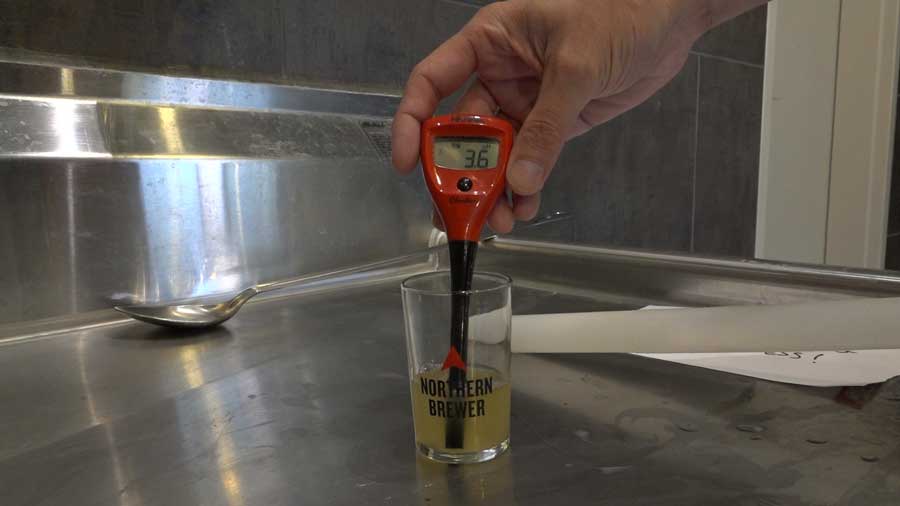October 07, 2020
How to Kettle Sour Beer

Like any trend in the brewing world, specific styles of beers come with specific techniques to make them a reality. New England IPAs, for example, can utilize non-traditional mash ingredients and also unique hopping schedules. When it comes to technique, sour beers are no different.
Traditionally, sour beers utilize a long, arduous aging period to allow various bacterial and/or yeast cultures to slowly turn the fermented beer into a wonderfully complex and tart delight. In practice, however, many brewers just do not have the patience to wait up to 24 months for the souring to occur. For these brewers (myself included), there exists a workaround to emulate a traditionally soured beer: Enter the kettle souring method.
Duck Duck Gose Recipe Kit: Extract | All-Grain
How to Kettle Sour Video
What Is Kettle Souring?
Kettle souring is a technique that allows brewers to rapidly sour unfermented wort in just a matter of days, often taking only a mere 24 hours. It could not be more simple - after creating wort and conducting a brief boil for sanitation, the wort is cooled to 75 - 95 degrees F (24 - 35 C) and a cultured strain (or blend of strains) of pure lactobacillus is introduced. Once introduced, the lactobacillus will go to work and begin consuming sugars in the wort transforming them into lactic acid, providing the tart flavor we know and love. Given some time, usually 1 to 3 days, the souring will be complete.
How do you know when it is done? Well, if you are the science-y type, bust out a pH meter and test the wort. We recommended these two pH meters: Checker 1 Economical pH Tester or Milwaukee pH56 pH/Temp Meter. For a subtle sourness, target a pH in the mid to upper 3s or if you want that awesome lip-puckering sourness, shoot for a pH in the lower 3s. Don’t have a pH meter? No worries, simply draw a small sample of the wort with a sanitized utensil and taste. When the wort has the desired sourness you can move on to the next step - boiling.
Why Use Kettle Souring?
Souring a beer this way has several benefits. First, the time frame. Being able to turn a sour beer in mere days is the obvious benefit. Second, since the wort is soured and then boiled to kill off the lactobacillus, you do not need to worry about infecting any equipment or contaminating any other batches in your fermentation area. Finally, since lactobacillus is extremely sensitive to isomerized alpha-acids (as little as 2 IBUs), this method allows you to make a hoppier sour beer than possible with the traditional method - think sour Imperial Stout for example.
Kettle Souring Tips
There are a few techniques that can help to make this method a success every time. Pre-acidification of the wort to pH 4.5 using a food grade acid (lactic or phosphoric) will do wonders in inhibiting other bacterial strains that may be present such as enteric bacteria. This acidification will also hamper the action of an enzyme lactobacillus uses to break down proteins, so your resulting beer will still showcase all the head retention and body that you would expect from the same beer fermented with only Saccharomyces.
Another helpful technique when kettle souring is to make a small starter 24 hours in advance to make sure the lactobacillus is up to the job. This starter does not have to be large - 1 cup of 1.040 starter wort will do the trick. A day after making the starter, create your wort, chill to around 85 degrees and add the entire starter to begin the souring process.
To help maintain warm temperatures recommended for the kettle souring process, we suggest using a setup similar to the one in the video above using our Fermentation Kit with Northern Brewer Dual Stage Temperature Controller. The combination of the Electronic Fermentation Heat Wrap and temperature controller allows you to choose and maintain the temperature at which you’d like your wort to sour over this period of one to three days
Don’t worry if the wort temperature drops to room temperature during the souring, my favorite lactobacillus strain (Omega Yeast Labs OYL-605) works incredibly well at lower temperatures due to its unique blend of bacteria strains. The wort will sour at a slightly slower pace, but it still beats waiting for up to two years!
It may seem a little daunting at first, but trust me, this is an incredibly easy and forgiving technique. Just make sure that your sanitation practices are impeccable as always, and enjoy your adventure into rapid-turn sour beers! Dive into the world of Kettle Sours with our traditional gose Duck Duck Gose recipe kit, a deliciously refreshing and mildly tart beer flavored with salt and coriander. Or try the Heiress de Bourgogne recipe kit. Inspired by the classic Flemish Red Ale, Heiress de Bourgogne is a deeply complex sour red ale with notes of raisins, dark stone fruits, and a delicate tartness. Best of all, we guarantee you'll have a fantastic result with this proven recipe.

Begin or continue your homebrew education with Northern Brewer University and our Homebrew Video Courses.
